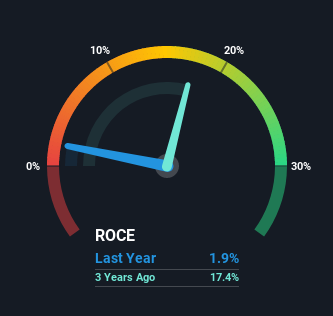Be Wary Of RedHill Education (ASX:RDH) And Its Returns On Capital
Finding a business that has the potential to grow substantially is not easy, but it is possible if we look at a few key financial metrics. In a perfect world, we'd like to see a company investing more capital into its business and ideally the returns earned from that capital are also increasing. This shows us that it's a compounding machine, able to continually reinvest its earnings back into the business and generate higher returns. However, after investigating RedHill Education (ASX:RDH), we don't think it's current trends fit the mold of a multi-bagger.
What is Return On Capital Employed (ROCE)?
If you haven't worked with ROCE before, it measures the 'return' (pre-tax profit) a company generates from capital employed in its business. To calculate this metric for RedHill Education, this is the formula:
Return on Capital Employed = Earnings Before Interest and Tax (EBIT) ÷ (Total Assets - Current Liabilities)
0.019 = AU$493k ÷ (AU$51m - AU$25m) (Based on the trailing twelve months to December 2020).
Thus, RedHill Education has an ROCE of 1.9%. Ultimately, that's a low return and it under-performs the Consumer Services industry average of 9.5%.
See our latest analysis for RedHill Education
Historical performance is a great place to start when researching a stock so above you can see the gauge for RedHill Education's ROCE against it's prior returns. If you'd like to look at how RedHill Education has performed in the past in other metrics, you can view this free graph of past earnings, revenue and cash flow.
How Are Returns Trending?
Unfortunately, the trend isn't great with ROCE falling from 13% five years ago, while capital employed has grown 88%. Usually this isn't ideal, but given RedHill Education conducted a capital raising before their most recent earnings announcement, that would've likely contributed, at least partially, to the increased capital employed figure. It's unlikely that all of the funds raised have been put to work yet, so as a consequence RedHill Education might not have received a full period of earnings contribution from it.
On a side note, RedHill Education's current liabilities have increased over the last five years to 49% of total assets, effectively distorting the ROCE to some degree. Without this increase, it's likely that ROCE would be even lower than 1.9%. And with current liabilities at these levels, suppliers or short-term creditors are effectively funding a large part of the business, which can introduce some risks.
The Bottom Line
From the above analysis, we find it rather worrisome that returns on capital and sales for RedHill Education have fallen, meanwhile the business is employing more capital than it was five years ago. Investors must expect better things on the horizon though because the stock has risen 8.3% in the last five years. Regardless, we don't like the trends as they are and if they persist, we think you might find better investments elsewhere.
If you want to know some of the risks facing RedHill Education we've found 2 warning signs (1 makes us a bit uncomfortable!) that you should be aware of before investing here.
For those who like to invest in solid companies, check out this free list of companies with solid balance sheets and high returns on equity.
This article by Simply Wall St is general in nature. It does not constitute a recommendation to buy or sell any stock, and does not take account of your objectives, or your financial situation. We aim to bring you long-term focused analysis driven by fundamental data. Note that our analysis may not factor in the latest price-sensitive company announcements or qualitative material. Simply Wall St has no position in any stocks mentioned.
Have feedback on this article? Concerned about the content? Get in touch with us directly. Alternatively, email editorial-team (at) simplywallst.com.

